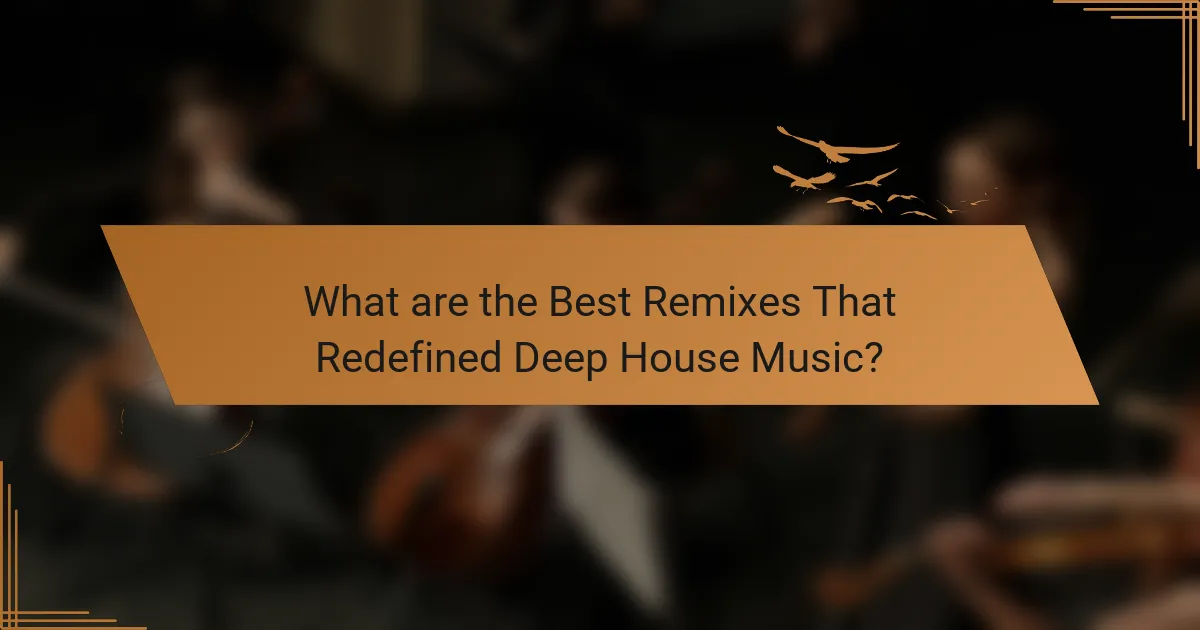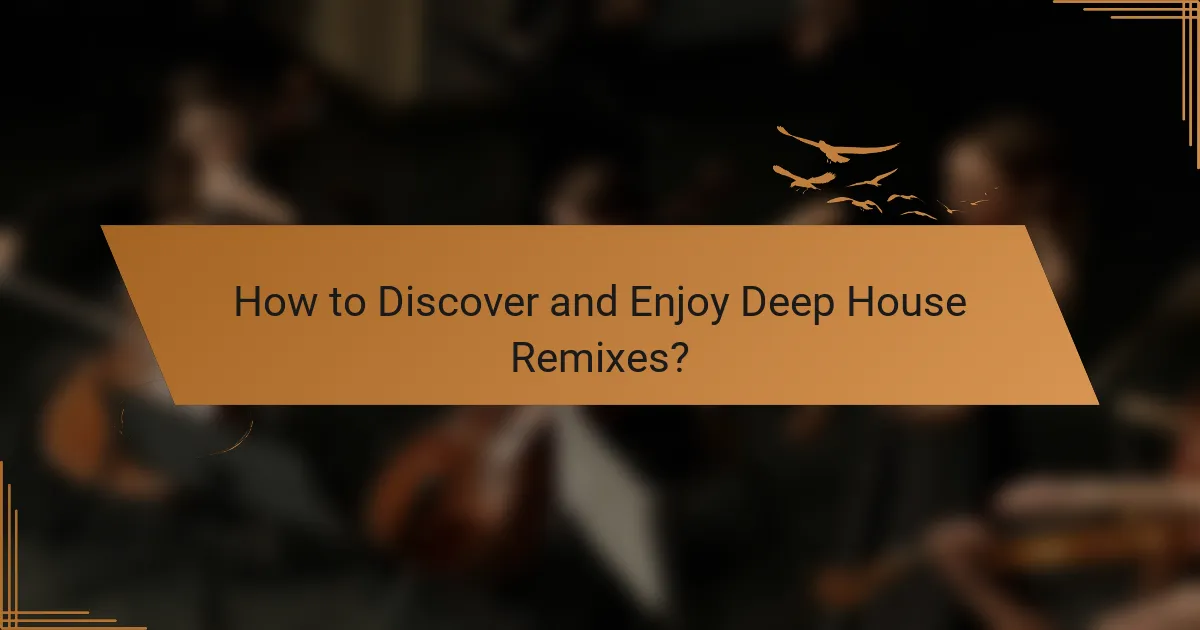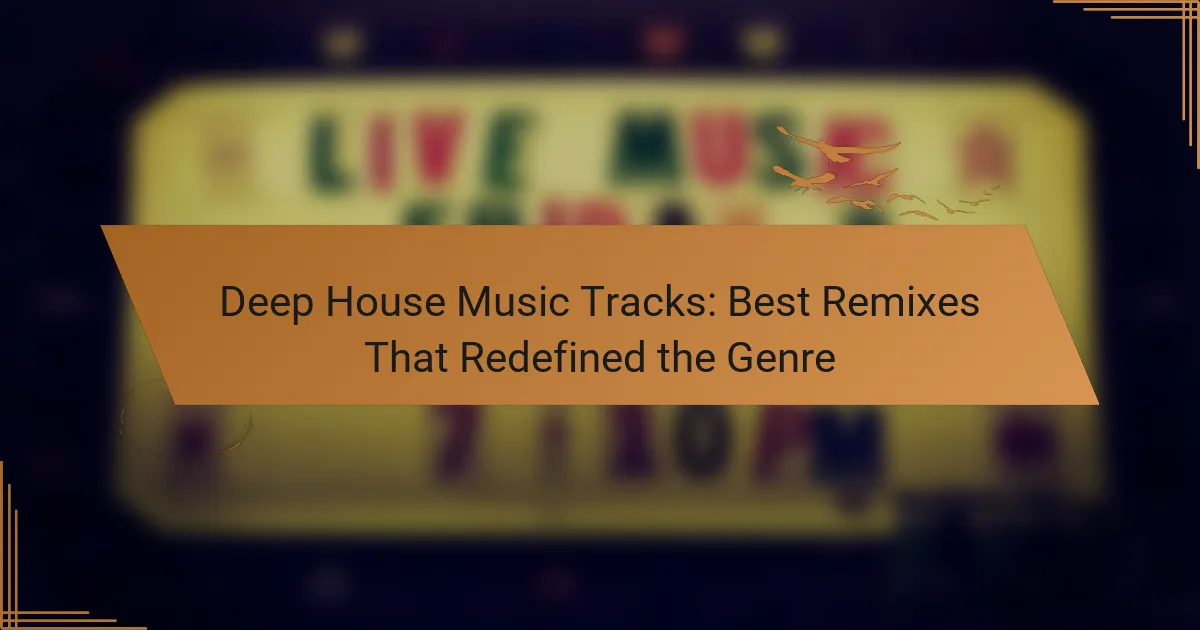Deep house music is a subgenre of house music known for its soulful melodies, complex harmonies, and slower tempo, typically between 120 to 125 beats per minute. This genre, which emerged in the 1980s with pioneers like Larry Heard and Frankie Knuckles, incorporates elements of jazz, funk, and ambient music, characterized by lush synths and deep basslines. Key remixes that have redefined deep house include “Can’t Get Enough” by Soulsearcher (DJ Sneak Remix), “Finally” by Kings of Tomorrow (Sandy Rivera’s Classic Mix), and “Deep End” by John Summit (Extended Mix), each contributing unique soundscapes and production techniques. This article explores these influential remixes, their impact on the genre, and ways to discover deep house music through various platforms and communities.

What is Deep House Music?
Deep house music is a subgenre of house music characterized by its use of soulful melodies and complex harmonies. It typically features a slower tempo, ranging from 120 to 125 beats per minute. Deep house often incorporates elements of jazz, funk, and ambient music. The genre emerged in the 1980s, with artists like Larry Heard and Frankie Knuckles pioneering its sound. Deep house tracks often utilize lush synths and deep basslines. Vocals in deep house are usually smooth and emotive, enhancing the genre’s atmospheric quality. The genre has gained popularity in club scenes worldwide, influencing many contemporary electronic music styles.
How did Deep House Music originate?
Deep House Music originated in the 1980s as a subgenre of house music. It emerged from the fusion of Chicago house and jazz-funk elements. Pioneers like Larry Heard and Frankie Knuckles played a significant role in its development. The genre is characterized by its use of soulful vocals and complex melodies. Deep house often features slower tempos, typically around 120 to 125 BPM. Its sound is marked by deep basslines and atmospheric synths. The genre gained popularity in clubs and underground scenes, particularly in the US and Europe. By the 1990s, deep house had established a distinct identity within the broader house music genre.
What are the defining characteristics of Deep House Music?
Deep House Music is characterized by its smooth, soulful sound and deep basslines. It typically features slower tempos, generally ranging from 120 to 125 beats per minute. The genre often incorporates intricate melodies and lush chords. Vocals in deep house tracks are usually soft and emotive, enhancing the overall atmosphere. Additionally, deep house music frequently employs elements of jazz, funk, and soul. The use of ambient sounds and atmospheric effects is also common. Its roots can be traced back to the 1980s Chicago house scene. This genre continues to evolve, influencing various other electronic music styles.
Who are the key pioneers of the Deep House genre?
Key pioneers of the Deep House genre include Larry Heard, Frankie Knuckles, and Kerri Chandler. Larry Heard, also known as Mr. Fingers, is credited with creating the deep house sound in the 1980s. His track “Can You Feel It” is a classic example of the genre. Frankie Knuckles, often referred to as the “Godfather of House,” played a significant role in popularizing deep house in Chicago. Kerri Chandler is known for his soulful productions and has been influential in shaping the sound of deep house. Their contributions have defined the genre and influenced countless artists.
Why is remixing important in Deep House Music?
Remixing is important in Deep House Music because it allows artists to reinterpret and innovate existing tracks. This practice enhances creativity within the genre. It also provides fresh perspectives on melodies and rhythms. Remixes can introduce new elements and styles, appealing to wider audiences. Historically, notable remixes have propelled tracks to greater popularity. For example, the “Deep Inside” remix by Hardrive became a classic, showcasing the power of remixing in Deep House. Additionally, remixing fosters collaboration among artists, enriching the musical landscape. Overall, remixing is a vital aspect of Deep House, driving its evolution and relevance.
What role do remixes play in the evolution of Deep House tracks?
Remixes play a crucial role in the evolution of Deep House tracks by introducing new sounds and interpretations. They allow artists to experiment with different styles while maintaining the core essence of the original track. Remixes can enhance the reach of a song by appealing to diverse audiences. This practice has been prevalent since the genre’s inception in the 1980s, where reimagined tracks contributed to its growth. Iconic remixes, such as those by Frankie Knuckles, have shaped the sonic landscape of Deep House. They often incorporate elements from various genres, enriching the overall sound. This blending of styles keeps the genre dynamic and relevant. Ultimately, remixes serve as a vehicle for innovation and collaboration within the Deep House community.
How do remixes enhance the listening experience of Deep House Music?
Remixes enhance the listening experience of Deep House Music by introducing new elements and perspectives to existing tracks. They often incorporate varied beats and instrumentation that can make the music more engaging. This variation can create a fresh auditory experience for listeners familiar with the original version. Remixes can also extend the duration of tracks, making them suitable for longer sets in DJ performances. Additionally, they allow for creative reinterpretations that can appeal to different audiences. By transforming the arrangement or adding vocals, remixes can evoke different emotions and atmospheres. The diversity in remixes helps maintain listener interest and can even introduce new fans to the genre.

What are the Best Remixes That Redefined Deep House Music?
The best remixes that redefined deep house music include “Can’t Get Enough” by Soulsearcher (DJ Sneak Remix), “Finally” by Kings of Tomorrow (Sandy Rivera’s Classic Mix), and “Deep End” by John Summit (Extended Mix). These tracks showcase innovative production techniques and unique soundscapes.
DJ Sneak’s remix of “Can’t Get Enough” introduced a funky bassline, enhancing its danceability. Sandy Rivera’s mix of “Finally” brought soulful vocals to the forefront, making it a timeless classic. John Summit’s “Deep End” features a catchy hook and infectious rhythm, capturing the essence of modern deep house.
These remixes have influenced countless artists and continue to be played in clubs worldwide. Each track has contributed to the evolution of deep house music, solidifying their status within the genre.
Which remixes have had the most significant impact on the genre?
“Deep House Music Tracks: Best Remixes That Redefined the Genre” includes remixes that significantly impacted deep house. Notable examples include the remix of “Can’t Get Enough” by Soulsearcher. This remix popularized the genre in the late 1990s. Another influential remix is “Finally” by Kings of Tomorrow, which became a classic anthem. The remix of “Deep End” by John Summit also gained widespread acclaim. These remixes helped shape the sound and direction of deep house music. Their impact is measurable through chart performance and club play. Each remix contributed to the genre’s evolution and mainstream acceptance.
What are the standout features of these influential remixes?
Influential remixes in deep house music often feature distinctive elements that redefine the genre. These remixes typically incorporate innovative beats and basslines that enhance the original track’s energy. They also utilize unique vocal arrangements, often layering harmonies or altering pitch to create a fresh sound.
Additionally, influential remixes frequently include atmospheric synths and pads, adding depth and texture. They may also introduce unexpected tempo changes or transitions that surprise listeners.
Moreover, these remixes often blend genres, integrating elements from pop, funk, or techno to broaden their appeal. The use of sampling from various sources adds a layer of creativity and nostalgia.
Overall, these standout features contribute to the remixes’ ability to resonate with both fans and critics, making them significant within the deep house music landscape.
How have these remixes changed the perception of Deep House Music?
Remixes have significantly altered the perception of Deep House Music. They have introduced new elements, making the genre more accessible to a broader audience. Popular remixes often incorporate diverse genres like pop and electronic dance music. This fusion has attracted listeners who may not typically engage with Deep House. Additionally, remixes highlight the genre’s versatility and creativity. They showcase innovative production techniques and fresh interpretations of classic tracks. As a result, remixes have played a crucial role in revitalizing interest in Deep House. Data from streaming platforms indicates increased plays for remixed tracks compared to original versions. This trend underscores the remixes’ impact on the genre’s popularity and cultural relevance.
Who are the notable remix artists in Deep House Music?
Notable remix artists in Deep House Music include Purple Disco Machine, MK, and Gorgon City. Purple Disco Machine is known for his disco-infused house remixes. MK gained fame for his remixes of tracks like “Look Right Through.” Gorgon City has a distinctive style blending deep house with pop elements. Other recognized remix artists are Claptone and Dennis Ferrer, who both contribute significantly to the genre. Their remixes often receive acclaim for enhancing original tracks while maintaining deep house’s essence.
What unique styles do these artists bring to their remixes?
Artists in deep house music bring diverse styles to their remixes. Each artist incorporates unique elements that redefine the genre. For instance, some artists blend soulful vocals with intricate melodies. Others may integrate jazzy chords and live instrumentation. Certain remixes emphasize a more minimalistic approach, focusing on deep basslines and subtle rhythms. Additionally, some artists experiment with ambient sounds and atmospheric effects. This variety enhances the listening experience and showcases the versatility of deep house. The fusion of these styles creates a rich tapestry of sound that captivates audiences.
How do these artists contribute to the Deep House community?
Artists contribute to the Deep House community by creating innovative tracks that push genre boundaries. They incorporate unique sounds and techniques that enhance the overall musical landscape. Their remixes often reinterpret classic Deep House tracks, giving them a fresh perspective. Collaborations among artists lead to diverse influences and styles within the genre. Live performances by these artists help to build a strong community atmosphere. They engage with fans through social media, fostering connections and discussions. Many artists also share production techniques and insights, promoting skill development among aspiring producers. Overall, their contributions help to evolve and sustain the Deep House community.

How to Discover and Enjoy Deep House Remixes?
To discover and enjoy deep house remixes, explore music streaming platforms like Spotify and SoundCloud. These platforms feature curated playlists dedicated to deep house remixes. Use genre-specific tags to filter your search for deep house tracks. Follow artists and labels known for deep house music to receive updates on new releases. Attend local clubs or events focused on deep house music for a live experience. Engage with online communities and forums dedicated to deep house to share recommendations. Listen to DJ sets, as they often include exclusive remixes that highlight the genre. Deep house remixes typically blend smooth melodies with a steady beat, making them enjoyable for both dancing and relaxation.
What are the best platforms for finding Deep House remixes?
SoundCloud, Bandcamp, and YouTube are among the best platforms for finding Deep House remixes. SoundCloud hosts a vast array of user-uploaded tracks and remixes. Many artists share their works there, making it a valuable resource. Bandcamp allows artists to sell their music directly to fans. It features a range of Deep House remixes available for streaming and purchase. YouTube offers numerous channels dedicated to Deep House music. Many DJs and producers upload their remixes, often with high-quality visuals. These platforms are widely recognized for their extensive collections and community engagement.
How can listeners curate their own playlists of Deep House remixes?
Listeners can curate their own playlists of Deep House remixes by selecting tracks that resonate with their personal taste. They should explore various music streaming platforms that offer Deep House genres. Popular platforms include Spotify, Apple Music, and SoundCloud. Users can search for curated playlists as inspiration. They can also follow Deep House artists and labels to discover new remixes. Additionally, utilizing features like ‘related tracks’ or ‘recommended for you’ can enhance their playlist. Listeners should pay attention to BPM and mood to maintain a cohesive sound. Engaging with Deep House communities online can provide further recommendations. Regularly updating the playlist with new finds keeps it fresh and exciting.
What tips can enhance the listening experience of Deep House Music?
To enhance the listening experience of Deep House Music, focus on high-quality audio equipment. Using headphones or speakers with a wide frequency range can improve sound clarity. Additionally, consider the acoustics of your environment. Listening in a quiet space minimizes distractions and allows for deeper immersion. Creating a playlist with well-curated tracks can also enhance the flow and mood. Engage with the music by paying attention to the intricate layers and rhythms present in Deep House tracks. Finally, explore various sub-genres to appreciate the diversity within Deep House Music.
How does the choice of environment affect the enjoyment of Deep House tracks?
The choice of environment significantly affects the enjoyment of Deep House tracks. Different settings can enhance or diminish the auditory experience. For instance, a club atmosphere with high-quality sound systems amplifies bass and rhythm, crucial elements in Deep House. Research indicates that environments with optimal acoustics improve listener satisfaction. Conversely, listening in a noisy or distracting setting can detract from the immersive qualities of the music. Studies show that emotional responses to music are heightened in comfortable and aesthetically pleasing environments. Therefore, the right environment can enhance the overall enjoyment of Deep House tracks, making it a vital factor in the listening experience.
Deep house music is a subgenre characterized by soulful melodies, complex harmonies, and slower tempos, originating in the 1980s with pioneers like Larry Heard and Frankie Knuckles. This article explores the best remixes that have redefined deep house, highlighting their significant impact on the genre’s evolution and popularity. Key topics include the defining characteristics of deep house, the role of remixing in enhancing tracks, and notable remix artists who contribute to the community. Additionally, it provides insights on discovering and enjoying deep house remixes through various platforms and tips for an enhanced listening experience.
